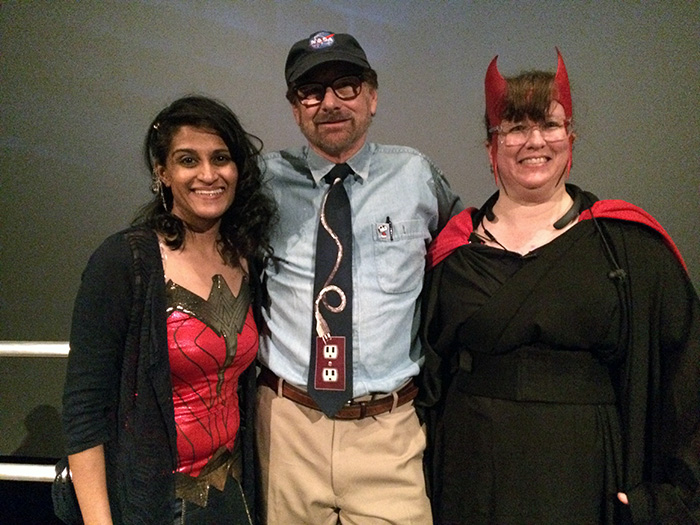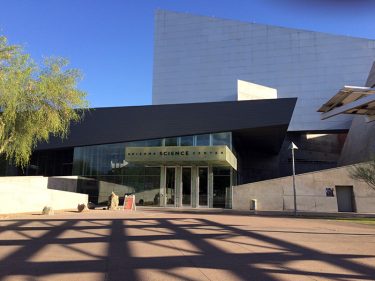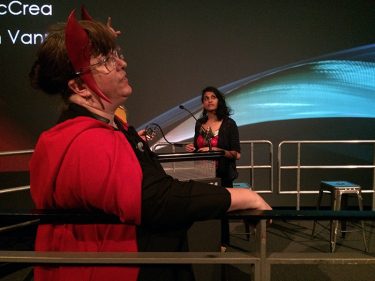
By Lana Sweeten-Shults
GCU News Bureau
Grand Canyon University’s Deborah Haralson, Scott McCrea and Dr. Binaben Vanmali may be mild-mannered GCU academics by day, but they're comic-book science debunkers by night. With a KABLAM! POW! BAM! and, of course, a WOW! these somewhat caped crusaders captivated a crowd of enthusiastic comic book fans Friday night at downtown’s Arizona Science Center.
The trio of fighters-against-wonky-science were the featured speakers at DC vs. Marvel night, part of the museum’s adults-only Science With a Twist series for those 21 years old and older who love anything science – and to partake of an adult beverage in a museum setting while wearing a superhero costume.
The reality-checking, interactive-audience talk looked at whether the science in recent comic book-based films actually could happen in reality or if it's the stuff of pure comic book imagination.
This wasn’t the first Arizona Science Center talk for Haralson, the College of Science, Engineering and Technology’s faculty lead in information technology. She also helmed a muggle-filled Harry Potter night forum at the facility a few months ago with fellow GCU professors Lindsey Kojich and Darien Hall.

Audience members at DC vs. Marvel night were invited to choose cryptic titles from the cinema-sized screen that were hyperlinks leading to clips from superhero films.
Haralson, dressed as X-Men superhero Wanda Maximoff, in red cape and headdress, and her fellow GCU academics covered topics that ranged from electromagnetic pulses to rockets vs. jets and whether The Flash really could eat enough to sustain his super-fast, crime-fighting tendencies.
In “Justice League,” Barry Allen, also known as The Flash, comments how he has to eat constantly to move as fast as he does: “I’m just a black hole of snacks. I’m a snack hole,” he says in the film.
Vanmali said the amount of calories he’d have to take in would be staggering.
“It’s physically impossible for him to be eating that much. … And then how much would he be spending on food every day?” she asked.
They also tackled the idea of The Flash’s race at the end of the film against Superman. The conclusion: The Flash would be traveling so fast his skin would peel off his face from the force of the wind and elements around him.
And then there was the idea of superheroes such as The Flash and Quicksilver being able to access “slices of time,” as Haralson put it, which is something regular ol' humans can't do.
“In (the film) ‘Lucy,’ they mentioned time is just solid. You can’t chop it up into pieces or anything like that,” she said. “Well, there is a popular theory that would say that humans are so slow they only see part of all of time. The idea here is, if you have an orchestra playing music, humans can only catch the downbeat, but people like Barry, those guys can access the other slices of time. … Is that possible in reality? Nobody really knows because it’s really difficult for us to test time.”
McCrea said there’s nothing humans have observed so far that would support the idea of time operating in different continuums:
“We can measure waves that have left thousands of light years ago and track their progress through the universe. If there were differences in time continuums, if there was a downbeat and upbeat, that would disturb those travels. We would have missing pieces because now you’re dealing with waves or particles that are operating at 186,000 miles per second traversing the galaxy.

“We can see them interact with gravitational fields. We can see them operate through dust particles and clouds, we can see them passing near black holes. … But if time was broken into segments, of which we can only see a quarter, that would manifest in our observation of what we can actually see.”
Haralson spoke of the twin paradox, which speaks to what would happen if one twin remained on earth while the other travels in a rocket that approaches the speed of light. When the second twin returns from space, he might be 20 minutes older, but the twin who stayed on earth would be dying of old age.
McCrea said that idea of humans going faster or slower than time is just a theory.
“In order to test that, you look once again to what can we observe using the web or the Hubble or any other space-based observational platform. … So far everything going on in the galaxy is in the same time frame, is made of the same elements, is using the same gravity, is having the same responses,” he said. ‘The galactic expansions are the same, the speed of light is the same, and everything that we’ve seen does not lead us to believe because of the non-occurrence in anything observable that these rips (in time) are able to take place.”
One of the topics McCrea tackled, after watching a clip from “Captain America: Winter Soldier,” was the idea of whether an electromagnetic pulse could wipe out a whole city, like in the film.
“When you take something sizable enough to create an EMP large enough to disable an entire city, it doesn’t go out in a nice, neat gridlock sequence, one building at a time (like in the film)," he said. "It all goes out at once. The problem with these sequences is if you create it, an electromagnetic pulse large enough to take out something the size of Las Vegas, you wouldn’t much care about the EMP because the energy to create it would look like a thermonuclear device. The city would be flattened before the lights went out.”
Then there’s that scene in “Spider-Man: Homecoming,” where a gaggle of tiny robots synchronize to put a ship back together.
“The amount of thrust needed … would squash him like an overripe grape,” McCrea said. “The robots would have to be controlled by an outside source managing them all. The amount of thrust depicted by the robots in the movie were not enough to move those gigantic pieces of ship around.”
Haralson waxed superheroic about Spider-Man’s web. At one point he tried to put a ship, cut in half, back together with his web. “We don’t know because the webs actually change their formula all the time,” she said, adding that in one film Spidey glued a guy to his car, saying the web would dissolve in two hours. “That tells me the web itself has openings in the molecular structure that allow for oxygen to corrode it over time, so if those openings are available for oxygen corrosion, that means they’re not available for strength, so chances are this ain’t going to happen.”
Haralson, McCrea and Vanmali also talked about magnetism vs. electricity, based on a clip from “Guardians of the Galaxy 2,” reusable rockets a la SpaceX, whether the villain Vulture could fly in that costume of his, and the hacking of Cyborg.
DC vs. Marvel night at the Arizona Science Center won’t be the last time Haralson, McCrea and Vanmali will be talking superheroes. If you missed their talk, you also can catch them May 24-27 at Phoenix Comic Fest, where they’ll helm talks about not only superheroes but Harry Potter.
You can reach GCU senior writer Lana Sweeten-Shults at 602-639-7901 or by email at [email protected].















